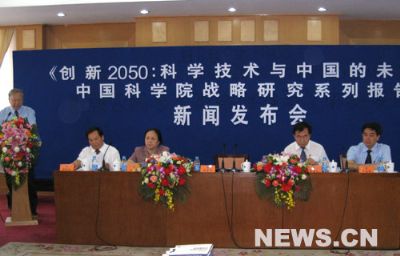
On June 10th, the Chinese Academy of Sciences held a press conference on the "Innovation 2050: Science and Technology Revolution and China's Future" series of strategic research reports of the Chinese Academy of Sciences in Beijing. The picture shows the speech of Vice Chairman of the National People's Congress Standing Committee and President of the Chinese Academy of Sciences Lu Yongxiang (first from the left). Xinhuanet
Xinhua News Agency, Beijing, June 10 (Yu Yu) The Strategic Research Series Report of the Chinese Academy of Sciences - "Innovation 2050: Technology Revolution and China's Future" was released in Beijing on the 10th. The report draws a map of China's science and technology development in 18 key areas such as energy, population health, space and ocean, information, and national and public safety in the next 50 years.
“People don’t have to worry about it and they have to worry about it. Many people in the past thought that science was hard to foresee, relying mainly on the creative thinking of scientists. However, taking energy as an example, we can foresee that in the next 50 years, renewable energy and nuclear power will surely have The new breakthrough progress is just a matter of a variety of specific technological paths,†Lu Yongxiang, vice chairman of the Standing Committee of the National People’s Congress and president of the Chinese Academy of Sciences, said at the press conference, formulating a strategy for scientific and technological development under the guidance of long-term goals through strategic research. The figure is feasible.
The report embodies more than 300 experts from the Chinese Academy of Sciences for more than one year. Based on the 2020, 2030 and 2050 stages, the report puts forward the overall concept of "Eight economic and social bases and strategic systems supported by scientific and technological innovation", namely, sustainable energy. And resource systems, advanced materials and smart green manufacturing systems, ubiquitous information network systems, ecological high-value agriculture and bio-industrial systems, inclusive health protection systems, ecological and environmental conservation development systems, new development systems for aerospace and marine capabilities, and countries Public safety system.
Lu Yongxiang said that the world today is on the eve of technological innovation breakthroughs and new technological revolutions. China must not simply copy the development model of other countries' science and technology, it must face the forefront of the world, proceed from the needs of China’s modernization process, and look forward to layout and key breakthroughs. Explore a path of technological innovation with Chinese characteristics. The road map released this time clarifies the focus of China’s future development and consolidates 22 strategic technology issues that affect China’s modernization process:
——Six strategic technical issues affecting China’s international competitiveness, including new principles of “post-IP†networks, research on new technologies, construction of trial networks, green preparation of high-quality basic raw materials, process engineering for resource-efficient clean recycling, and agriculture Molecular design of animal and plant species, ubiquitous sensing information manufacturing system, and Ai (1018) supercomputing technology.
—— Seven strategic scientific and technological issues affecting China’s capacity for sustainable development, including China’s underground 4,000-meter transparent plan, new renewable energy power system, deep geothermal power generation technology, new nuclear power system, marine capacity development plan, stem cell and regenerative medicine, Early diagnosis and systemic intervention of major chronic diseases.
- Two strategic technological issues affecting national and public safety, namely, space situational awareness networks and social computing and parallel management systems.
- Four basic scientific issues that may have revolutionary breakthroughs, including exploration of dark matter and dark energy, regulation of physical structure, artificial life and synthetic biology, photosynthesis mechanism.
- Three rapidly advancing crosscutting directions, including nanotechnology, space science exploration and satellite series, mathematics and complex systems.
"These strategic technology issues have not yet been deployed or deployed in China's current scientific and technological planning. It is appropriate to use the state's actions to give full play to the advantages of concentrating on major issues and to adopt strategic pilot special scientific and technological projects, major scientific research plans, or major research areas, clusters, etc. We will continue to work on ways to organize and implement the issue.†Lu Yongxiang said that the road map will be revised every five years to provide scientific advice for the country’s macro scientific and technological decision-making, so as to achieve the goal of relying on scientific and technological innovation to promote economic and social development.
